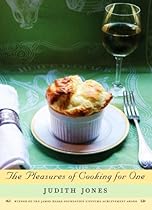
I have several other "cooking for 1" cookbooks and have found many good recipes there. But this is the cookbook I've been waiting for. Ms. Jones has shown me how to take ingredients that cannot be purchased in small quantities and re-use these imaginatively to create entirely different meals.
For example, a pork tenderloin becomes a small roast, scallopine, a gratinate, hash, and stir fry. Her examples have encouraged me to improvise myself. I can envisage a BBQ pork sandwich, a pasty with leftover pork tenderloin, skirt steak and potatoes.
She encourages playing with the recipes to create a meal exactly to your own tastes. Several of her recipes also include vegetable substitution recommendations allowing for seasonal meals. Or, if you're like me and can't stand a particular vegetable then you can swap it for something more palatable.
This cookbook creates a solid foundation for enabling a cook's creativity. Highly recommended.

















